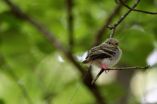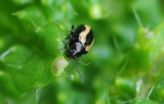Fungus may help stop invasive spread of tree-of-heaven
2014-05-08
(Press-News.org) A naturally occurring fungus might help curb the spread of an invasive tree species that is threatening forests in most of the United States, according to researchers.
Researchers tested the fungus -- Verticillium nonalfalfae -- by injecting it into tree-of-heaven, or Ailanthus, plots, according to Matthew Kasson, who recently received his doctorate in plant pathology and environmental microbiology from Penn State. The treatment completely eradicated the tree-of-heaven plants in those forests.
"It appears that this treatment is effective in Pennsylvania and could be used as a bio-control agent throughout the United States," said Kasson.
Since tree-of-heaven's introduction into Pennsylvania in the 1780s, the tree has spread from a rare and prized plant for collectors to a nuisance in at least 40 of the 48 contiguous states, according to Kasson.
"Trying to find the best way to get rid of tree-of-heaven has become a serious land-management issue," said Kasson. "Fire doesn't seem to work and chemicals and mechanical means are expensive and ineffective, too."
Using a hatchet that is designed to pump fungal spores into the trees, the researchers tested the fungus on 14 tree-of-heaven stands in south-central Pennsylvania. Usually, it takes three blows of the hatchet to deposit the entire inoculation of about 30 million spores for each tree. The inoculation kills the entire tree, including the sprouts. The researchers report their results in a recent issue of Phytopathology.
"It's important that the sprouts are killed, too, because, tree-of-heaven has an extensive system of sprouts that spread just above the ground surface, which is one of the reasons the tree is so difficult to manage," said Kasson. "The sprouts can immediately grow even if the top canopy of trees dies."
Don Davis, professor of plant pathology, Penn State, said that in 2003, he noticed a large number of tree-of-heaven deaths in a southwestern Pennsylvania forest. The foresters in the area then took him to a site where large-scale wilt was affecting the trees.
"There were hundreds if not thousands of dying and dead tree-of-heaven in the area, which is very unusual, because tree-of-heaven is very hard to kill," said Davis.
The researchers noticed a number of Ambrosia beetles near the infected stands, leading them to theorize that the fungus, often carried through the forests by beetles, was involved in the tree deaths.
"The Ambrosia beetles may explain some of the long-range spread of the disease," said Davis. "One theory is that the beetles feed on an infected tree and then take those spores to another healthy tree, which could be miles away."
The effect that the fungus has on other plants will be the subject of further research, Kasson said. However, preliminary studies on the vegetation that surrounds Ailanthus groves indicate the fungus may not harm nearby plants and trees. Only a small percentage of plants near the infected tree-of-heaven plots showed signs of being harmed by the fungus.
"There are still tests and studies that need to be done in the future to make sure it's completely safe," said Kasson. "As a researcher, you can't be sure until the results of all of those tests are in, but, at this point, I am cautiously optimistic."
INFORMATION:The U. S. Department of Agriculture and Pennsylvania Department of Conservation and Natural Resources supported this work.
ELSE PRESS RELEASES FROM THIS DATE:
New paper provides important insights into carcinoma-associated fibroblasts
2014-05-08
A new paper by a team of researchers led by Zachary T. Schafer, Coleman Assistant Professor of Cancer Biology in the Department of Biological Sciences at the University of Notre Dame, offers important new insights into the role carcinoma-associated fibroblasts (CAFs) play in tumor biology. A number of recent studies have revealed CAFs to be a major contributor to tumor progression through a variety of mechanisms. Despite this information, the precise role CAFs play in augmenting the growth of tumors is still poorly understood.
In their new paper, Schafer and his fellow ...
'Teenage' songbirds experience high mortality due to many causes, MU study finds
2014-05-08
Nearly one-third of songbird species across North America are experiencing long-term declines. Scientists have spent years researching potential causes for these population declines, focusing on the birds when they have just hatched as well as when they are adults. Now, researchers from the University of Missouri and the U.S. Department of Agriculture have found that songbirds are vulnerable to environmental dangers particularly when they are juveniles, shortly after they have left their parents' nests. Frank Thompson, a scientist with the USDA Forest Service and an associate ...
Hepatitis C virus: How viral proteins interact in human cells
2014-05-08
Viruses use human cells in order to multiply and spread. This process involves interactions with cellular host factors as well as virus-virus interactions. For example interactions among viral proteins are essential for the assembly of newly produced infectious virions.
Interaction network explains viral mechanisms and opens up possibilities for new treatments
Hepatitis C virus (HCV) forms a precursor protein, which is processed into ten viral proteins. Scientists at the Institute of Virology at the Helmholtz Zentrum have now discovered how these proteins interact with ...
Promising role for interleukin-10 in scarless wound healing
2014-05-08
New Rochelle, NY, May 8, 2014—The powerful anti-inflammatory compound interleukin-10 (IL-10) plays a crucial role in regenerative, scarless healing of fetal skin. Studies of IL-10 in postnatal skin wounds have demonstrated its promise as an anti-scarring therapeutic agent, as described in a Critical Review article published in Advances in Wound Care, a monthly peer-reviewed journal from Mary Ann Liebert, Inc., publishers and an Official Journal of the Wound Healing Society. The article is available free on the Advances in Wound Care website.
In "Regenerative Wound Healing: ...
Detecting trace amounts of explosives with light
2014-05-08
University of Adelaide research may help in the fight against terrorism with the creation of a sensor that can detect tiny quantities of explosives with the use of light and special glass fibres.
Published in the journal Sensors and Actuators B: Chemical, the researchers describe a novel optical fibre sensor which can detect explosives in concentrations as low as 6.3 ppm (parts per million). It requires an analysis time of only a few minutes.
"Traditionally explosives detection has involved looking for metals that encase them such as in land mines," says project leader ...
'Parent' cells reset the cell division clock
2014-05-08
Melbourne researchers have overturned a 40-year-old theory on when and how cells divide, showing that 'parent' cells program a cell division time for their offspring that is different from their own.
Scientists from the Walter and Eliza Hall Institute have shown that both phases of the cell cycle contribute to the overall change in division time rather than one staying fixed in duration as previously thought. They have developed these findings into a new model that helps scientists predict how a population of cells has divided.
Their research could impact our understanding ...
Low-carbohydrate diet reduced inflammation
2014-05-08
A low-carbohydrate diet, but not a low-fat diet, reduces inflammation in patients with type 2 diabetes, according to research at Linköping University in Sweden.
It is known that patients with type 2 diabetes have higher levels of inflammation than those who do not have the disease, and it is believed that this may contribute to a higher risk of cardiovascular disease and other complications. In a clinical trial at Linköping University a low-carbohydrate diet was compared with a traditional low-fat diet in 61 patients with type 2 diabetes. Only patients in the low-carbohydrate ...
Public perceive alcohol adverts breach regulatory code, research finds
2014-05-08
A majority of the UK general public perceive alcohol adverts to breach the Advertising Standards Authority's Broadcast Committee of Advertising Practice (BCAP) Code suggesting that the current regulatory system for UK television is inadequate, research from The University of Manchester shows.
Researchers surveyed 373 adults, aged 18-74 years, showing them one of seven adverts that had been broadcast in the previous month on leading commercial television channels.
Overall 75 per cent of the participants rated the adverts as breaching at least one rule from the BCAP Code ...
Beetles that taste like mustard
2014-05-08
Almost all herbivorous insects are specialized to feed on specific host plants and have adapted to their chemical defenses. Flea beetles are important pests of cabbage and other cruciferous plants, such as mustard, horseradish and rapeseed. These plants use a sophisticated defense system, known as the mustard oil bomb, to get rid of their enemies : If plant tissues are wounded, glucosinolates and an enzyme known as myrosinase come into contact, and, as a result, toxic metabolites are formed which deter most insects. This defensive mechanism, however, has no negative effect ...
Pesticides: Research provides new insights into their effects on shrimps and snails
2014-05-08
Ground breaking research by an international team of scientists has resulted in greater understanding of the effects of pesticides on aquatic invertebrates such as shrimps and snails.
Research published in the journal Environmental Science & Technology by a team of scientists from the UK, Switzerland and Finland provides an important new approach for systematically measuring and modelling the sensitivity of aquatic invertebrates to various pesticides.
Aquatic invertebrate species are abundant in European freshwaters and play an important role in the decomposition of organic ...



